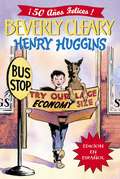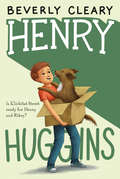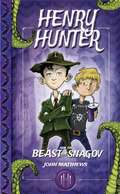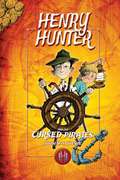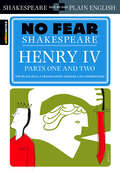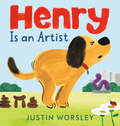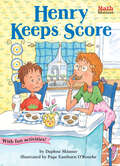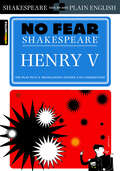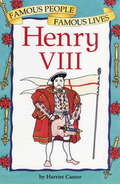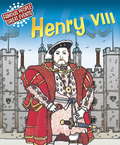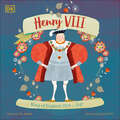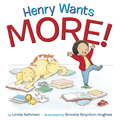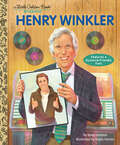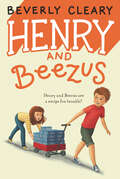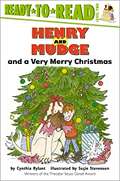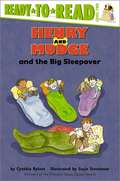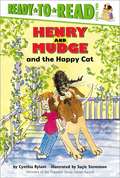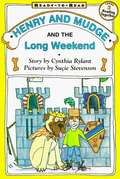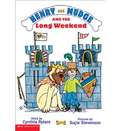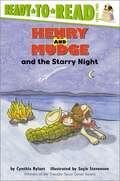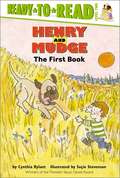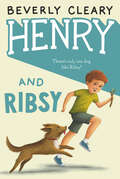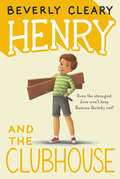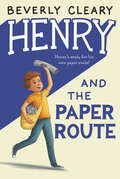- Table View
- List View
Henry Holton Takes the Ice
by Sandra BradleyA lively hockey and ice dancing picture book in the tradition of Billy Elliot and The Sissy DucklingHenry Holton’s whole family is hockey mad. Everyone, that is, except Henry. When he holds a hockey stick, Henry becomes a menace to the game—and an embarrassment to his sports-minded family. It’s not until he sees his first ice dancing performance that Henry realizes there’s something he can do on the ice that doesn’t involve boarding and body checking. Henry is ready to hang up his gear and try on some figure skates, but first he has to convince his hockey-obsessed family to let him follow his own path.
Henry Huggins (Henry Huggins #1)
by Beverly ClearyLa vida cambia para Henry Huggins con la aparición de Ribsy, un perro flaco y desgarbado que encuentra un día a la salida de la Y.M.C.A. Juntos corren toda clase de aventuras, desde perder un hermoso balón de fútbol, hastacelebrar una Navidad "verde". Con Ribsy aprende el valor del trabajo, el respeto a la propiedad ajena y también que todos merecemos ganar un premio, incluso un perro feúcho y de raza desconocida. Pero lo más importante para Henry será averiguar con quién decidirá quedarse Ribsy.
Henry Huggins: Henry Huggins (spanish Edition) (Henry Huggins #1)
by Beverly Cleary Jacqueline RogersIn the first novel from Newbery Award-winning author Beverly Cleary, boys and girls alike will instantly be charmed by an average boy whose life is turned upside down when he meets a lovable puppy with a nose for mischief.<P><P> Just as Henry Huggins is complaining that nothing exciting ever happens, a friendly dog sits down beside him and looks pleadingly at his ice-cream cone. From that moment on, the two are inseparable. But when Ribsy's original owner appears, trying to reclaim his dog, Henry's faced with the possibility of losing his new best friend. Has Klickitat Street seen the last of rambunctious Ribsy?
Henry Hunter and the Beast of Snagov: Henry Hunter Series #1 (Henry Hunter Series #1)
by John MatthewsAdolphus Pringle lived a relatively normal life before he met Henry Hunter, but being the best friend of a twelve-year-old millionaire genius certainly makes life interesting. He has accompanied Henry on adventures all over the world and encountered dozens of supernatural creatures. Henry has a penchant for paranormal mysteries, and he never fails to drag his trusty sidekick, Dolf, into adventures to track down the truth in these mystical legends.Henry announces one morning that he and Dolf are going to go in search of a creature more terrifying than Dracula himself: the Beast of Snagov. The pair of supernatural investigators travel from where Bram Stoker stayed in Whitby to Transylvania. Along the way they come across some strange things such as Dracula’s daughter, Bella, and an organization called the Order of the Dragon that wants to sacrifice Henry Hunter to the Beast of Snagov. When Henry is taken, it’s up to Dolf and Bella to team up and rescue him!Will Henry survive this supernatural adventure? Get ready to discover the world of the supernatural through the eyes of our spooked narrator as he tags along on the first adventure in the Henry Hunter series!Sky Pony Press, with our Good Books, Racehorse and Arcade imprints, is proud to publish a broad range of books for young readers-picture books for small children, chapter books, books for middle grade readers, and novels for young adults. Our list includes bestsellers for children who love to play Minecraft; stories told with LEGO bricks; books that teach lessons about tolerance, patience, and the environment, and much more. While not every title we publish becomes a New York Times bestseller or a national bestseller, we are committed to books on subjects that are sometimes overlooked and to authors whose work might not otherwise find a home.
Henry Hunter and the Cursed Pirates: Henry Hunter Series #2 (Henry Hunter Series #2)
by John MatthewsHenry Hunter’s friend Charlie is desperate for help. His parents have gone missing in the Caribbean Ocean, and no one will believe him that something sinister is afoot. Henry and his sidekick Dolf are on the case! The only lead Henry and Dolf have is the sighting of a ghostly galleon and a huge tentacle of mist. Exploring the local pirate history and myths, Henry and Dolf uncover a cursed crew of pirates, led by no other than the deadly Edward Teach—Blackbeard himself. But what's keeping the pirates sailing beyond their deaths? And how and why are they building a crew of live prisoners? It's up to Henry and Dolf to survive monster waves and befriend a crazy local seadog to solve the mystery and put the pirates back in their watery graves!Discover the ghostly world of the paranormal through the eyes of our spooked narrator as he tags along on the second adventure in the Henry Hunter series!
Henry IV Parts One and Two: No Fear Shakespeare Side-by-Side Plain English (No Fear Shakespeare)
by William Shakespeare SparkNotesThis No Fear Shakespeare ebook gives you the complete text of Henry IV Parts One and Twoand an easy-to-understand translation.Each No Fear Shakespeare containsThe complete text of the original playA line-by-line translation that puts Shakespeare into everyday languageA complete list of characters with descriptionsPlenty of helpful commentary
Henry Is an Artist
by Justin Worsley⋆"A masterpiece of excremental fiction."--Booklist (starred review) "Calls to mind Harry the Dirty Dog and that classic canine Clifford . . . a delightfully oddball tale." --Kirkus reviews A hilariously funny and unique story about Henry, a dog who is disappointed when the new pieces of "art" he creates each day on his walks to the park are continuiously thrown in the garbage!Henry is a dedicated artist, a master sculptor, and . . . a dog. Each day on his walks to the park, he leaves his new "art" for people to admire. But his sculptures keep getting tossed in the garbage without even being noticed! That is until, one day, when someone quite unexpected falls in love with his work and at last Henry has his moment to shine.This tongue-in-cheek and truly unique picture book about creativity, perseverence, and, well, poop, is a hilarious ode to undiscovered artists everywhere. Perfect for readers who loved No One Likes a Fart, My Butt is So Noisy, and Peter Reynolds's Creatrilogy.
Henry Keeps Score (Math Matters)
by Daphne SkinnerDiscover Math Matters! With over 15 million books sold worldwide, this award-winning series of easy-to-read books will help young readers ages 5–8 approach math with enthusiasm. Great for fans of MathStart or Step into Reading Math. Henry wants to make sure that his older sister Harriet never gets more of anything than he does. So he carefully keeps score and discovers that sometimes 0 is better than 1!With engaging stories that connect math to kids&’ everyday lives, each book in the Teachers&’ Choice Award–winning Math Matters series focuses on a single concept and reinforces math vocabulary and skills. Bonus activities in the back of each book feature math and reading comprehension questions, and even more free activities online add to the fun! (Math topic: Comparing)
Henry V: No Fear Shakespeare Side-by-Side Plain English (No Fear Shakespeare)
by William Shakespeare SparkNotesThis No Fear Shakespeare ebook gives you the complete text of Henry Vand an easy-to-understand translation.Each No Fear Shakespeare containsThe complete text of the original playA line-by-line translation that puts Shakespeare into everyday languageA complete list of characters with descriptionsPlenty of helpful commentary
Henry VIII: Famous People, Famous Lives
by Harriet CastorExciting stories about famous people, outlining their lives and the important events which made them memorable. Every page features easy-to-follow text and a black-and-white line drawing to help bring these events to life. Each title gives further facts about the famous person and the times in which he or she lived, plus a comprehensive time line detailing key dates. Henry VIII is an exciting tale of kings and queens, jousting knights and grisly executions. It explains how Henry took power away from the Church in his quest for an heir to inherit his kingdom.
Henry VIII: Famous People, Great Events
by Harriet CastorExciting stories about famous people, outlining their lives and the important events which made them memorable. Every page features easy-to-follow text and a black-and-white line drawing to help bring these events to life. Each title gives further facts about the famous person and the times in which he or she lived, plus a comprehensive time line detailing key dates. Henry VIII is an exciting tale of kings and queens, jousting knights and grisly executions. It explains how Henry took power away from the Church in his quest for an heir to inherit his kingdom.
Henry VIII: King of England 1509 - 1547 (History's Great Leaders )
by Ben HubbardDelve into the past and explore the life and reign of Henry VIII in this biography for children brought to you by the publisher of Queen Elizabeth: A Platinum Jubilee Celebration and King Charles III.The third book in this captivating series on British monarchs, Henry VIII covers all the key moments in the fascinating man's life, from his struggles to father a son and the fates of his six wives, to the formation of the Church of England and wars with France and Scotland.Bright, playful illustrations and simple, age-appropriate text ensure that this book is the perfect introduction to the infamous Tudor king for little historians everywhere. It will supplement your child's learning and curiosity as it reveals the secrets of a larger-than-life king from long ago.
Henry Wants More!
by Linda AshmanMore games, more races, more tickles, more books--little Henry can't get enough! When a toddler is armed with that useful word and the world is full of brand-new things, his family just doesn't stand a chance. Follow Henry on his exhausting and all-too-familiar day filled with play . . . and a lot of love! Buoyant rhymes and charming illustrations strike a heartwarming note that will ring true with families of energetic little ones.
Henry Winkler: A Little Golden Book Biography (Little Golden Book Biographies)
by Betsy GrobanCelebrate beloved actor and children's book author Henry Winkler with this collectible Little Golden Book, featuring an accessible font for readers with dyslexia!Henry wants all children with dyslexia to know that they are smart and can do great things.Henry Winkler has never let anything stop him from following his dreams, from growing up in New York City with a learning disability to his iconic role as The Fonz on TV's Happy Days, to his success as a children's book author and advocate for helping children with learning challenges. This heartwarming biography includes full-color illustrations and a special font used to make reading more accessible for people like Henry who struggle with dyslexia.This Little Golden Book Biography is perfect for Henry Winkler fans of all ages and families looking for inspiring stories about people with learning disabilities.Little Golden Book biographies feature the iconic gold-foil design and share the life stories of extraordinary artists, world leaders, performers, and athletes including:Oprah WinfreyCarol BurnettDick Van DykeSteven Spielberg
Henry and Beezus (Henry Huggins #2)
by Beverly Cleary Tracy DockrayFor the well-meaning Henry Huggins, nothing ever works out quite as planned—including getting the bike of his dreams. Luckily his pal Beezus Quimby is there to help!<P><P> Henry's attempts at raising money for his bike fund keep falling flat. Selling bubble gum on the playground gets him in trouble with his teacher, and then Ribsy's nose for mischief almost ruins Henry's paper route. Even pesky little Ramona Quimby manages to get in the way of Henry's chance at a bike. But no matter what, Henry can always count on reliable Beezus to stick by his side.<P> Newbery Medal winner Beverly Cleary portrays a genuine friendship, while telling a very funny story boys and girls alike will enjoy.
Henry and Mudge and a Very Merry Christmas (Henry And Mudge #25)
by Cynthia RylantChristmas at Henry and Mudge's house means cookies and carols and presents, and the whole family gathering for a delicious breakfast (with lots of food falling on the floor for Mudge). It may just be the best Christmas ever — but Henry's favorite present is the big, lovable dog he's had all along.
Henry and Mudge and the Big Sleepover (Henry And Mudge #28)
by Cynthia RylantHenry and his dog Mudge are invited to a sleepover in Patrick's attic, where they watch monster movies, eat pizza, and enjoy a contest to determine whose dog is the best popcorn catcher.
Henry and Mudge and the Happy Cat (Henry and Mudge #8)
by Cynthia RylantIn this eighth book in the Henry and Mudge series, Henry and his dog Mudge take in a stray cat. It's not a pretty cat, but it is a happy cat and it loves Mudge!
Henry and Mudge and the Long Weekend
by Cynthia RylantHenry and his dog Mudge build an indoor castle in this eleventh Ready-to-Read book of their adventures. Henry and his 180-pound dog Mudge are best friends forever. And on a long weekend, they build a glorious indoor castle, complete with knights and kings! Ready-To-Read Level 2.
Henry and Mudge and the Long Weekend: The Eleventh Book of Their Adventures
by Cynthia Rylant Suçie StevensonNIMAC-sourced textbook
Henry and Mudge and the Starry Night: Ready-to-read Level 2 (Henry And Mudge Ser.)
by Cynthia RylantHenry, his big dog Mudge, and his parents go on a quiet camping trip to Big Bear Lake, enjoying the clean smell of trees and wonderful green dreams.
Henry and Mudge: The First Book of Their Adventures
by Cynthia Rylant<P>When Henry asks his parents for a baby brother, they say "No!" When Henry begs to move to a street with children, his parents say "No!" When Henry asks for a dog, his parents almost say "No!" Good thing they didn't say it, because Henry and Mudge are best pals. <P>Other books about their adventures are available from Bookshare. [This text is listed as an example that meets Common Core Standards in English language arts for grades 2-3 at http://www.corestandards.org.]
Henry and Ribsy (Henry Huggins #3)
by Beverly Cleary Tracy DockrayHenry's father promises to take him salmon fishing if he can keep Ribsy out of trouble for the next month. But that's no easy task, especially when Ramona gets into the act.In this humorous and heartfelt novel from Newbery Medal-winning author Beverly Cleary, the bond between a boy and his dog proves strong, as Henry vows to stick up for Ribsy... even if he is a trouble-maker!<P><P> From the first moment Henry found Ribsy, the curious mutt was poking his nose into things he shouldn't be. Whether terrorizing the garbage man, chasing cats, or gobbling Ramona Quimby's ice-cream cone, Henry's four-legged pal has walked himself into one problem too many. So when Henry asks his dad if he can go along on the big fishing trip, Mr. Huggins agrees, but on one condition: Ribsy must stay out of mischief for two whole months. Henry is confident in his loyal dog... until Ribsy goes overboard with his appetite for chaos... literally!<P> Winner of Pacific Northwest Library Association’s Young Reader’s Choice Award
Henry and the Clubhouse (Henry Huggins #5)
by Beverly Cleary Tracy DockrayFiery Ramona Quimby and the well-meaning Henry Huggins may clash, but in this delightful and hilariously told novel by Newbery Medal-winning author Beverly Cleary, an unlikely compromise wins the day.<P><P> Henry and his friends are building a no-girls-allowed clubhouse. With a private space of their own away from everyone else—and even a top secret entry password—they're all thrilled with their boy fort. But Henry's about to find out that nothing—not even a sign—will keep gutsy Ramona out of their clubhouse…and her retaliation may just ruin Henry's newspaper career.
Henry and the Paper Route (Henry Huggins #4)
by Beverly Cleary Tracy DockrayNewbery Medal-winning author Beverly Cleary gives readers a hero they'll relate to--and root for--in this comical and inspiring novel about Henry Huggins's mission to prove himself worthy of his very own paper route.<P><P> All the older kids work their own paper route, but because Henry is not eleven yet, Mr. Capper won't let him. Desperate to change his mind, Henry tries everything he can think of to show he's mature and responsible enough for the job. From offering free kittens to new subscribers, to hauling hundreds of pounds of old newspapers for his school's paper drive, there's nothing Henry won't try. But it might just be the irrepressible Ramona Quimby who shows Mr. Capper just how capable Henry is.<P> Winner of Pacific Northwest Library Association’s Young Reader’s Choice Award

